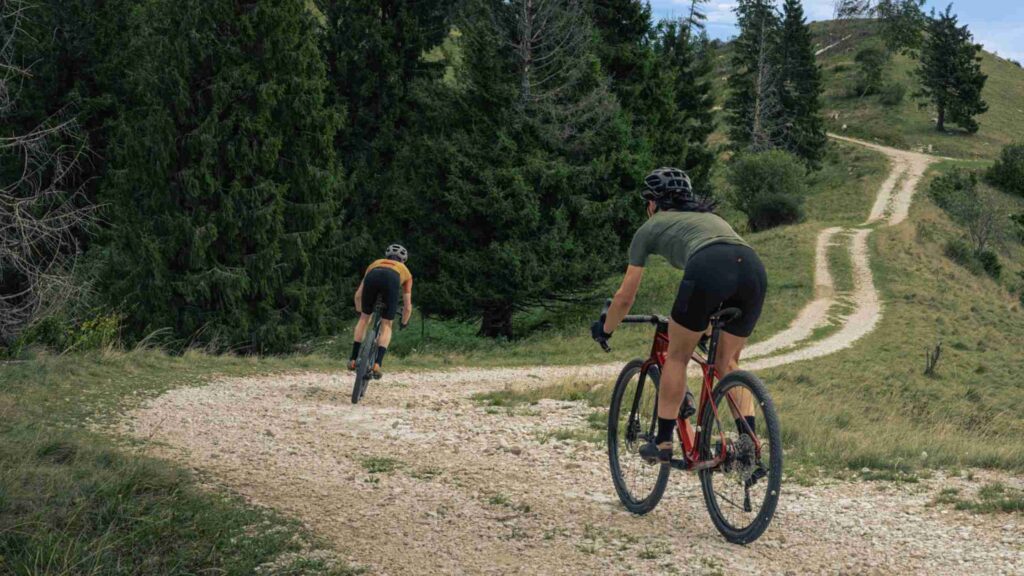When cyclists reach out to Elastic Interface®, more than 90% of inquiries are about long distance cycling pads. It’s no coincidence: riding 100, 150, or even 200 kilometers means putting your chamois under constant stress — humidity, vibrations, and posture changes all challenge comfort and performance.
In these conditions, the pad must endure, protect, and maintance consistent comfort —no matter the terrain or the weather.
In this guide, you will discover:
- The technical differences between short-, medium-, and long-distance cycling pad
- The key factors for choosing the best pad for rides over 100 km
- The top Elastic Interface® long distance chamois models
- Practical tips to make the most of your long-distance pad
Long-distance cycling pads: key features
For rides lasting 4 to 8 hours or more, not just any padding will do. You need a chamois made with materials, densities, and shapes that stay comfortable and supportive over time.

What defines a top-performing endurance chamois pad?
- Multi-density foams: the longer the ride, the more protection you need. Premium foams provide true support only if they resist compression to prevent bottoming out. In Elastic Interface® pads, density reaches up to 200 kg/m³ in the Hybrid Cell System (HCS) technology, combining closed-cell foam for support and open-cell foam for breathability — delivering lasting comfort and optimal thermoregulation.
- Elastic memory and shape retention: the pad must maintain its properties after hours of compression. Elastic memory ensures the chamois returns to its original shape ride after ride.
- Breathability and moisture control: on demanding rides, keeping skin dry is crucial. The Super Air Layer technology, with perforated fabric, promotes moisture evaporation and airflow. The Air Mapping structure — featuring foam-free areas — enhances ventilation, allowing air to circulate freely for stable, long-term comfort.
- Vibration absorption: internal layering helps dampen micro-impacts, a key factor on mixed or gravel terrains.
- Anatomy and stability: a poorly positioned pad can cause irritation, affect posture, and compromise performance. A well-designed chamois ensures anatomical stability, perfect body adherence, and correct alignment under the sit bones.
In summary, the ideal long-distance cycling pad should:
- maintain ischial and perineal support
- ensure stability and grip in the saddle
- wick away moisture quickly to reduce friction and irritation
- offer controlled ventilation through perforated foams
- preserve elasticity and thermal comfort in all conditions
Choosing the right pad for 100+ km: autumn and gravel riding
One of the most common questions we receive is: “Which pad would you recommend for a 100+ km gravel ride in fall conditions?”

To answer, let’s break down five essential factors:
- Mixed terrain: you need a versatile pad that protects both ischial and perineal zones.
- Seasonal conditions: fall often means higher humidity and lower temperatures — the pad must dry quickly and remain breathable under thermal layers.
- Ride duration: for rides of 100, 200, or even 300 km (5+ hours in the saddle), the padding must ensure consistent and even pressure distribution.
- Riding style: more dynamic on gravel, more stable on the road – the chamois must adapt to different cycling positions.
- Fit and stability: the pad should stay perfectly in —no shifting, no folds, no friction.
The best Elastic Interface® chamois pads for long-distance riding
Elastic Interface® technlogies are designed for cyclists who push beyond limits — whether road endurance, gravel, or ultracycling.
The Long Distance collection offers densities up to 200 kg/m³, with optimized comfort, support, and airflow.
Icarus HCS
Engineered for ultra-endurance road and gravel rides, Icarus HCS provides superior ischial support thanks to its HCS 200 kg/m³ density. The combination of closed-cell foam (for support) and open-cell foam (for breathability and heat dispersion) ensures consistent comfort even after six hours or more. The ergonomic central channel relieves perineal pressure and enhances airflow.
Road Performance Force HCS
The top-tier choice for gran fondos, brevets, and ultracycling. It features triple-density HCS foam and an Air Mapping structure that optimizes air circulation. Ideal for long road rides, it balances support, elasticity, and thermal control perfectly.
Explorer HCS
Designed for cyclists who alternate between road and gravel. The Hybrid Cell System absorbs vibrations and promotes rapid heat dissipation, keeping skin dry even on humid terrain. Its ergonomic design provides freedom of movement and stability on any route.
Endurance Lunar HCS
Built for long-distance endurance rides. The HCS 200 kg/m³ foam provides extended support, while open-cell layers guarantee continuous ventilation. Transition zones reduce vibration and improve posture stability—ideal for autumn or mid-season rides, where moisture and temperature control are key.
All Terrain Performance
As the name suggests, this model is made for cyclists who ride everywhere—road, gravel, or off-road.
It uses a three-foam sandwich (two reticulated) to enhance breathability and quick drying. With 110 kg/m³ density foam and adaptive support (80 kg/m³) that follows body movement, it ensures comfort, ventilation, and responsiveness even in extreme conditions.
Every cyclist is unique, but comfort should never be optional. Choosing the right long-distance pad means investing in performance, health, and enjoyment on the bike.
Explore the full Elastic Interface® Long Distance range in the Technologies section of our website, or check our partner brands to find the cycling shorts that turn every mile into pure riding pleasure.

